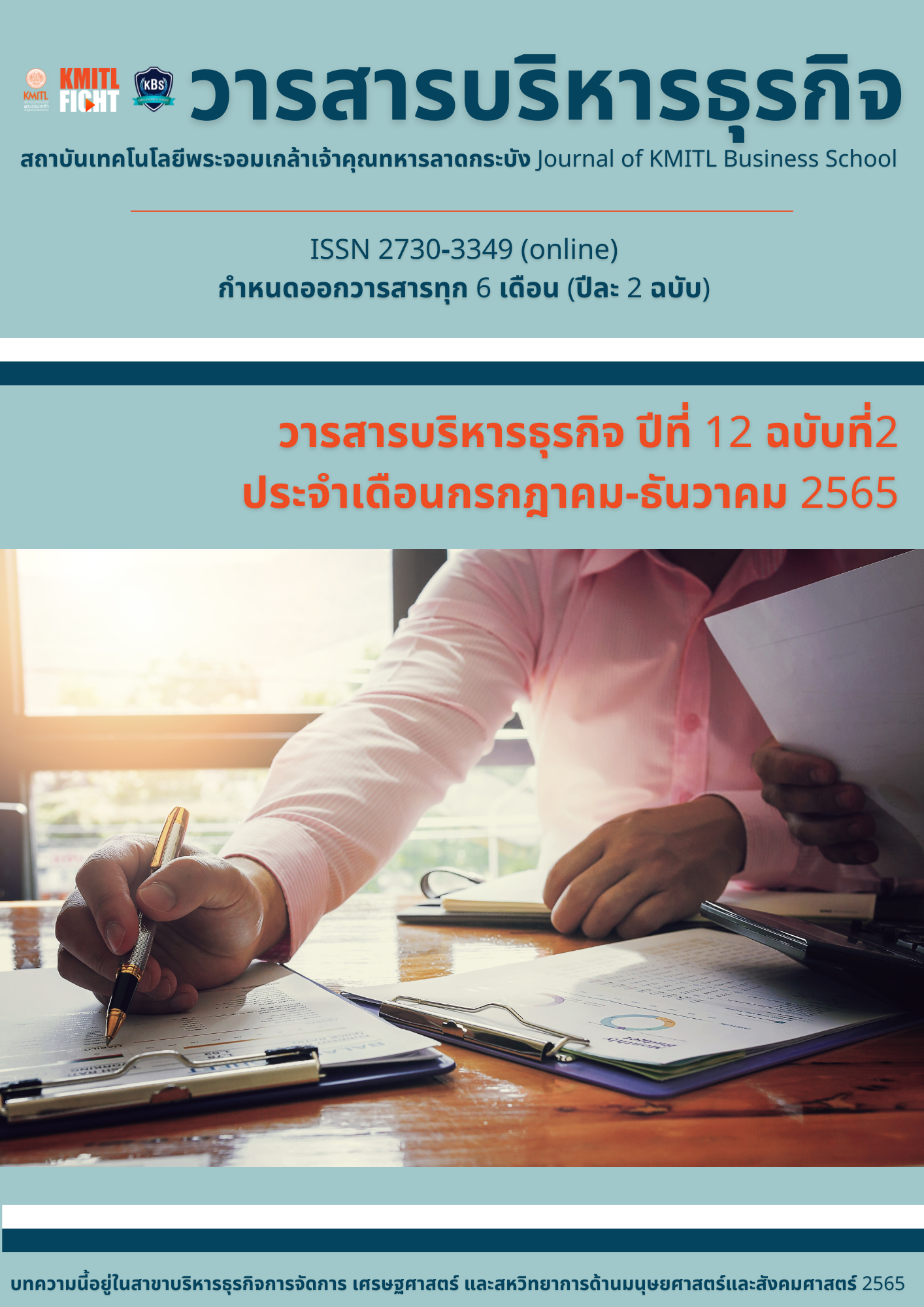LIFESTYLES AND CONSUMERS’ PURCHASE INTENTION OF SELF-HEATING FOOD
Main Article Content
Abstract
This research aimed to study the lifestyle and consumers’ purchase intention for self-heating food. The sample in this research consisted of 400 consumers who interested in purchasing or bought self-heating food. The data were collected using a questionnaire. The statistics for data analysis included percentage, mean, and standard deviation, organizing the lifestyle pattern by factor analysis and cluster analysis. The hypotheses were tested with a One-Way Analysis of Variance. The research result showed that most respondents were sloth lifestyles. The hypothesis testing was as follows: Consumers with different lifestyles had a different effect on purchasing intentions for self-heating food with a statistical significance of 0.05.
Article Details

This work is licensed under a Creative Commons Attribution-NonCommercial-NoDerivatives 4.0 International License.
Journal of KMITL Business School is available both online and in printed version.
**All articles or opinions presented in this issue of the Journal of KMITL Business School reflect the thoughts of their respective authors. This journal serves as an independent platform for a variety of viewpoints. Authors bear full responsibility for the content of their articles.**
**All articles published in this journal are copyrighted by KMITL Business School, King Mongkut's Institute of Technology Ladkrabang. The editorial team permits copying or using articles, but a reference to the journal is required.**
References
Ei, T. P. M. T. (2017). Design of Self heating Instant Noodle Packaging. (Master of Engineering in Industrial and Manufacturing Engineering). Asian Institute of Technology School of Engineering and Technology Thailand.
กรมส่งเสริมการค้าระหว่างประเทศ (2020). ผลิตภัณฑ์อาหารสำเร็จรูปแบบอุ่นร้อนเองได้มาแรงรับกระแสไวรัสโควิด 19
Marshall, B. (2003). How MREs Work. Retrieved from https://science.howstuffworks.com/mre4.htm
Steven, M. S. (2006). The Fire Safety Hazard of the Use of Flameless Ration Heaters Onboard Commercial Aircraft. National Technical Information Service (NTIS).
ifood.tv. (2020). Self-heating Can. Retrieved from https://ifood.tv/equipment/self-heating-can/about
สาระเรื่อยเปื่อย. (2021). เบื้องหลังของ “ถ้วยร้อน” ที่สามารถอุ่นอาหารได้โดยไม่ต้องใช้ความร้อน. In.
Hu Min. (2019). Self-heating hotpots are a real blast. Retrieved from https://www.shine.cn/news/metro/1903121067/
กัสจังหม้อไฟเกาหลี. (2565). กัสจังหม้อไฟเกาหลี บะหมี่กึ่งสำเร็จรูปที่ร้อนเองได้ไม่ใช้น้ำร้อน. In.
ถ้วยร้อน. (2564). New! Hotto Cup ราคาถ้วยละ 35 บาท 3 ถ้วย 100 บาท. In.
Miss Zaap-มิสแซ่บ. (2564). #จั๊บแซ่บ ก๋วยจั๊บญวน. In.
mum.official. (2565). หม้อร้อน แม่อิพิม ร้อนเองได้ พิมรี่พาย หม้อร้อน hotbox พิมนิยม pimrypie ของกิน มาม่า. In.
Chimdoo office. (2565). ชิมดู ข้าวแกงหม้อไฟ (Ready to Eat. In.
บุกแปรรูป โมคิ. (2563). หม่าล่าหม้อไฟ ร้อนเองได้. In
karoks. (2565). สุกี้หม่าล่าหม้อไฟ อร่อยเผ็ดชา เครื่องเยอะ ร้อนเองได้ไม่ต้องต้ม ชาบูหมาล่าพกพา Haidilao. In.
matemate. (2564). โออิชิ จัด “หม้อแบบอุ่นร้อนเองได้” กินกันได้ง่ายๆ บริการเดลิเวอรี่ถึงบ้าน.
กัลยา วานิชย์บัญชา. (2562). การวิเคราะห์สถิติขั้นสูงด้วย SPSS for Windows (พิมพ์ครั้งที่ 14..): กรุงเทพฯ : ศูนย์หนังสือแห่งจุฬาลงกรณ์มหาวิทยาลัย ผู้จัดจำหน่าย.
สุภมาส อังศุโชติ และคณะ. (2552). สถิติวิเคราะห์สำหรับการวิจัยทางสังคมศาสตร์และพฤติกรรมการศาสตร์ เทคนิคการใช้โปรแกรม Lisrel (พิมพ์ครั้งที่ 3). กรุงเทพฯ: เจริญดีมั่นคงการพิมพ์.
กัลยา วานิชย์บัญชา. (2552a). การวิเคราะห์ข้อมูลหลายตัวแปร (4). กรุงเทพมหานคร: ภาควิชาสถิติ คณะพาณิชยศาสตร์และการบัญชี จุฬาลงกรณ์มหาวิทยาลัย.
อำนวย มณัศรีวงศ์กูล. (2541). Cluster Analysis. วารสารวิจัย มหาวิทยาลัยขอนแก่น.
ปรนมน ปัญญาไตรรัตน์. (2565). รูปแบบการดำเนินชีวิตและนวัตกรรมที่มีผลต่อการตัดสินใจซื้ออาหาร Meal Kit ของผู้บริโภคในยุคฐานวิถีชีวิตใหม่ (New Normal) ในเขตกรุงเทพมหานคร. วารสารวิทยาการจัดการปริทัศน์ ปีที่ 24 ฉบับที่ 1 (มกราคม-เมษายน 2565) 43.


